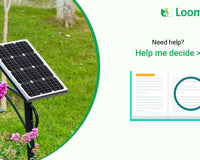Recently, there is no other source of renewable energy that can be used by everyone to save money instead of solar energy, specifically If you are living in India. As India is blessed with abundant PSH (Peak sunshine hours) across all regions and in every direction. We will include the following topics:
Why Solar Energy?
Solar energy generates electricity from sunlight, and I already mentioned that we have abundant sunlight across all regions. So, installing solar system can be a more profitable deal than any other source of renewable energy. Wind and Hydro energy are more expensive than solar energy. And it is limited to some regions only. Where Solar is forever and for everyone.
How to Install Solar Panel?
Installing solar panels involves several steps to ensure a safe and efficient setup. Here's a general overview of the process:
1. Determine Feasibility: Evaluate your property's suitability for solar installation. Factors like sunlight exposure, shading, roof orientation, and local regulations can affect the efficiency of your solar panels.
2. Choose Solar Panels: Select the type and brand of solar panels you want to install based on your energy needs, budget, and available space. Monocrystalline, polycrystalline are common types of solar panels.
3. Gather Equipment: Apart from the solar panels themselves, you'll need mounting racks, inverters, wiring, conduit, junction boxes, and any necessary safety equipment.
4. Install Mounting Hardware: Attach the mounting racks to the roof. This is usually done using bolts or brackets that are securely fastened to the roof structure.
5. Install Solar Panels: Affix the solar panels to the mounting racks. Follow the manufacturer's guidelines for spacing, angling, and securing the panels properly.
6. Connect Wiring and Inverter: Connect the wiring from the solar panels to the inverters and from the inverters to your electrical panel.Install the inverters in a well-ventilated and accessible location. They convert the DC power generated by the solar panels into usable AC power for your home.
7. Turn On the System: Once you receive approval, you can start generating solar power for your home. Monitor your system's performance regularly and address any issues promptly.
8. Enjoy Solar Savings: With your solar panel system up and running, you can start enjoying reduced energy bills and the environmental benefits of clean energy production.
Government Incentives
The government of India introduced various incentives for solar system. some of the popular incentives are:
- Loan and financing: It makes your solar installation more affordable.
- Subsidies: These are direct payments or discounts by the government that reduce the upfront cost of purchasing and installing a solar PV system. But the percentage of subsidy varies in locations, and it is only available for below 10 kW system.
- Feed-in-tariffs (FiTs): These are policies that guarantee a fixed price for the electricity generated by solar PV systems and fed into the grid.
It's important to note that the availability and terms of financing options may vary based on the specific location and size of the commercial solar project. Before making any financing decisions, it is advisable to consult with a renewable energy consultant or financial advisor who can provide tailored advice based on the current market conditions.












